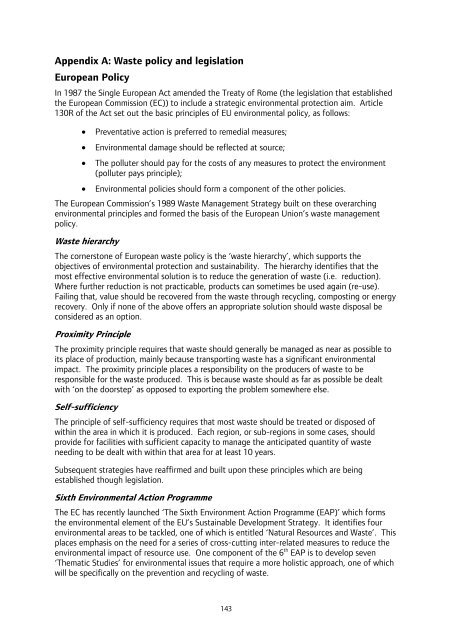London Wider Waste Strategy - London - Greater London Authority
London Wider Waste Strategy - London - Greater London Authority
London Wider Waste Strategy - London - Greater London Authority
Create successful ePaper yourself
Turn your PDF publications into a flip-book with our unique Google optimized e-Paper software.
Appendix A: <strong>Waste</strong> policy and legislation<br />
European Policy<br />
In 1987 the Single European Act amended the Treaty of Rome (the legislation that established<br />
the European Commission (EC)) to include a strategic environmental protection aim. Article<br />
130R of the Act set out the basic principles of EU environmental policy, as follows:<br />
• Preventative action is preferred to remedial measures;<br />
• Environmental damage should be reflected at source;<br />
• The polluter should pay for the costs of any measures to protect the environment<br />
(polluter pays principle);<br />
• Environmental policies should form a component of the other policies.<br />
The European Commission’s 1989 <strong>Waste</strong> Management <strong>Strategy</strong> built on these overarching<br />
environmental principles and formed the basis of the European Union’s waste management<br />
policy.<br />
<strong>Waste</strong> hierarchy<br />
The cornerstone of European waste policy is the ‘waste hierarchy’, which supports the<br />
objectives of environmental protection and sustainability. The hierarchy identifies that the<br />
most effective environmental solution is to reduce the generation of waste (i.e. reduction).<br />
Where further reduction is not practicable, products can sometimes be used again (re-use).<br />
Failing that, value should be recovered from the waste through recycling, composting or energy<br />
recovery. Only if none of the above offers an appropriate solution should waste disposal be<br />
considered as an option.<br />
Proximity Principle<br />
The proximity principle requires that waste should generally be managed as near as possible to<br />
its place of production, mainly because transporting waste has a significant environmental<br />
impact. The proximity principle places a responsibility on the producers of waste to be<br />
responsible for the waste produced. This is because waste should as far as possible be dealt<br />
with ‘on the doorstep’ as opposed to exporting the problem somewhere else.<br />
Self-sufficiency<br />
The principle of self-sufficiency requires that most waste should be treated or disposed of<br />
within the area in which it is produced. Each region, or sub-regions in some cases, should<br />
provide for facilities with sufficient capacity to manage the anticipated quantity of waste<br />
needing to be dealt with within that area for at least 10 years.<br />
Subsequent strategies have reaffirmed and built upon these principles which are being<br />
established though legislation.<br />
Sixth Environmental Action Programme<br />
The EC has recently launched ‘The Sixth Environment Action Programme (EAP)’ which forms<br />
the environmental element of the EU’s Sustainable Development <strong>Strategy</strong>. It identifies four<br />
environmental areas to be tackled, one of which is entitled ‘Natural Resources and <strong>Waste</strong>’. This<br />
places emphasis on the need for a series of cross-cutting inter-related measures to reduce the<br />
environmental impact of resource use. One component of the 6 th EAP is to develop seven<br />
‘Thematic Studies’ for environmental issues that require a more holistic approach, one of which<br />
will be specifically on the prevention and recycling of waste.<br />
143
















